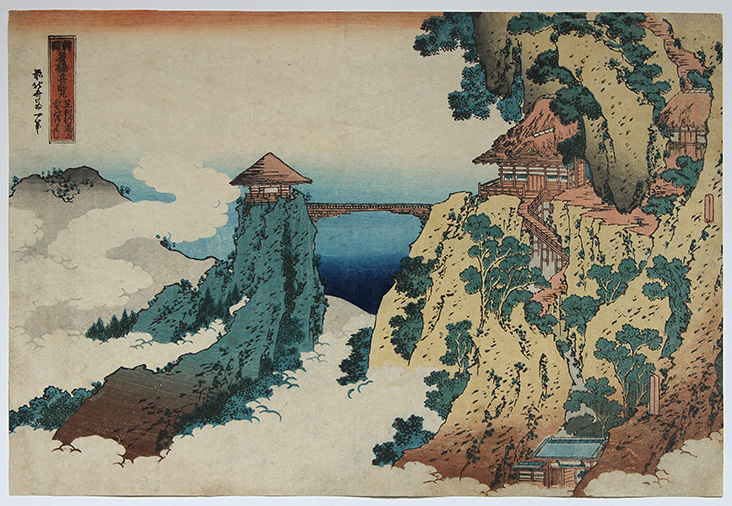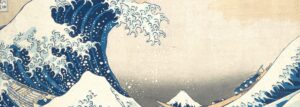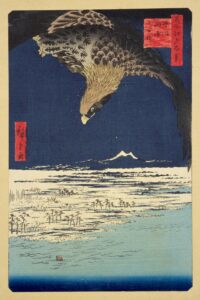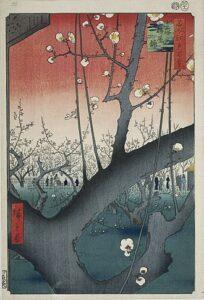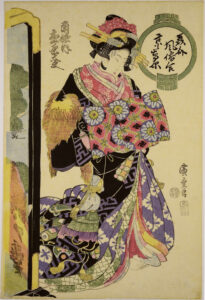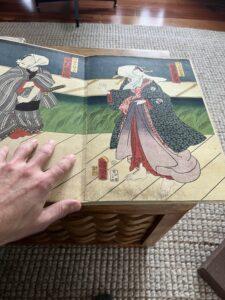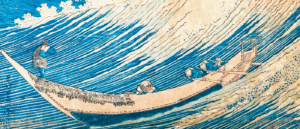by ARY RENAN
Thou, whom we call “Hokusai”, venerable artist of this Japan that we would know and love, do thou impart to us some of thy secrets! Thou art always young, and we grow prematurely old. We hear that thou hadst the weight of fifty-four years
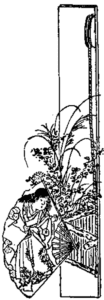
upon thee when thou didst commence thy Manga, but we know that thou created it in the spirit of a youth of twenty years. Repeat to us, Genius of the North, that thou hast always loved Nature—tell us that she is a sweet mistress ! One will perhaps look at her with more loving eyes when the age of spectacles is reached. What tender feelings must she have for him who, since his first youth, has given himself up to her worship !
Is it merely a love-affair or a solemn marriage ? It argues, somehow or other, that Nature and the Japanese must be very opposed in sentiment to each other that we should be in error when we. state that they had formed a love-match, an indestructible and passionate alliance.
Whatever may happen, whatever discovery may be made, whatever the yet unknown, the extreme East, may have in reserve for us, we shall always be sure that the Japanese have been real lovers of nature, and that Hokusai is a charming entertainer. One might well have carved on his modest tomb the verses that the scholars of the Renaissance composed for the tomb of Virgil, ” Here rests he whom Nature feared as her rival, and whose funeral seemed, as it were, her own.”
If it is admitted that Hokusai is worthy a place in the first rank of independent and original artists, one must assign to him immediately a characteristic which he shares with the most highly inspired of the masters of our Western Art, namely, unconsciousness. It is clear that this wonderful man never knew his own value. We know that he lived in poverty, died at an advanced age and full of years—that he worked for trade purposes, didmuch book-illustration, and changed his residence and his name according to his fancy. From this we gather that he was a philosophical and simple artist, applying himself to all branches of art, identifying himself with no particular one—in fact, an inspired being, a nomad of the great artist-family. If we could have paid him a visit some fifty years ago, perhaps in some little room in Yedo, and if we had told him that what came from his brush would in the hereafter be an invaluable and world-wide lesson—he would in all probability have laughed at us. And perhaps we might have done him harm—we might have altered his simplicity.
Japan was in his time in a healthy state ; but there were evidently then, as now, various forms of public opinion. That of the old school attached itself to ancient forms, as a protest against the popular school which also had its public. The genius of Hokusai pleased the humble mind, whose instinctive criticism appreciated the novelty of his manner—an æstheticism more liberal, with stronger lines and greater wealth of fancy combined with a thorough intention of following Nature in her most rapid changes, than the schools which preceded it.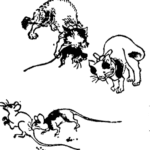
Hokusai worked because of his personal desire to do so—because he longed to create—like Rembrandt when he engraved on copper—without thinking of himself. He threw to the winds his lovely works, which disappeared it mattered not where. They now return to us, forming hundreds of volumes which we do not hesitate to add to the library of Art which includes the whole world.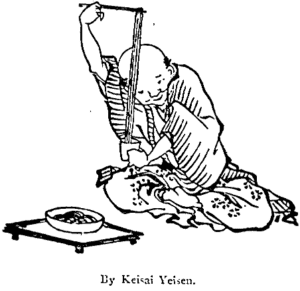
It is not our purpose now to study Hokusai as a painter—he was a great painter—but as a designer of illustrations; and as such his Man-gwa is doubtless his greatest work. Man-gwa means literally “rapid sketches,” and we have fourteen portfolios of these, containing some thousands of varied subjects, printed in the simplest manner at a minimum of expense. No one can pass over the marvellous effects produced by the Japanese in wood-engraving and coloured printing. In the last number of this magazine we gave a lengthy explanation of their method of work.
It is curious that the Japanese have never taken to engraving on copper. The reason in all probability is because their only instrument for writing is the brush, charged with Indian-ink—at the same time the freest and the broadest of all writing appliances. Hokusai had the good fortune to have his originals beautifully engraved —as facsimiles of brush-work nothing can equal a good copy of the Man-gwa ; it seems as if they were the original drawings from the artist’s hand.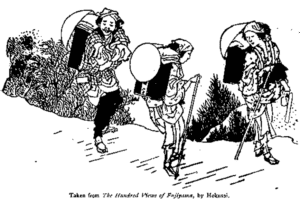
The Man-gwa is, as it were, an encyclopædia. The Japanese, imitating the Chinese, appear to have always taken pleasure in repetitions, and their methodical minds delighted in classification and information set out in regular order. Thus it is that they were induced to make a species of index to Nature herself. The Man-gwa is neither the first or the only dictionary of this description.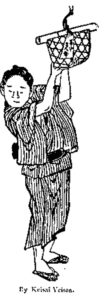
Beginning in 1745, Morikuni published, in nine volumes, the Jiki-Shiho an encyclopædia of the designer’s art. One finds there examples of the methods of drawing flowers, birds, trees, landscapes, or groups; and there are other collections which resemble celebrated works by Japanese and Chinese artists of later date. Scenes of popular life and theatrical incidents were collected in theImbut-susogwa(1722), in the Yeihon Yamato-hiji, besides a quantity of other volumes. According to local custom, collections such as these and the Man-gwa are intended for instruction, and may almost be termed school-book’s. They are intended to pass fromhand to hand, to be useful to young people, artists, and more particularly to artisans.
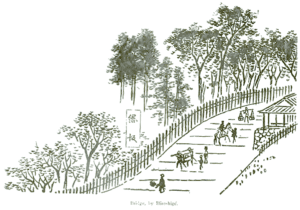 It is impossible to repeat too often that the union of the arts—smaller and greater—is perfect in Japan ; the study of nature is their common base. Drawing is thus the foundation of the industrial arts themselves. In the famous epoch of Genroku (1688-1704), Korin, a thoroughly impressionist artist, and making lacquer himself, gave designs for lacquer-makers. I His family revived the Ceramic Art. They who engraved sword-guards were painters in their way ; and such were the designers for the cotton-weavers and embroiderers—Moronobu, Goshin, Toyokuni.
It is impossible to repeat too often that the union of the arts—smaller and greater—is perfect in Japan ; the study of nature is their common base. Drawing is thus the foundation of the industrial arts themselves. In the famous epoch of Genroku (1688-1704), Korin, a thoroughly impressionist artist, and making lacquer himself, gave designs for lacquer-makers. I His family revived the Ceramic Art. They who engraved sword-guards were painters in their way ; and such were the designers for the cotton-weavers and embroiderers—Moronobu, Goshin, Toyokuni.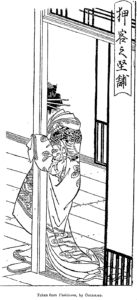 Hokusai himself gave models for china-manufacturers, lacquerers, and decorators of every sort.
Hokusai himself gave models for china-manufacturers, lacquerers, and decorators of every sort.
Let us see Hokusai such as he is, when depicted by himself in a little preface which he wrote, and which is just what we can imagine of him. ” Since I was six years old,” says the painter, ” I have been in the habit of drawing the shapes of objects. Towards my fiftieth year I published an infinity of designs ; but I am not satisfied with anything I produced before my sixtieth year. It is at my seventieth year that I am more or less able to understand the forms of birds, fishes, etc.This preface finishes in the hope that—”at the age of a hundred and ten everything from my brush, whatever it is, may be full of life.”
Let us picture him to ourselves at the edge of a rice-field, out for a walk, enveloped in fog, or leaning out of his window. The world seems to him a diorama. Exterior objects all strike him with an almost equal intensity ; he has not the idea of things that are worth and that are not worth reproducing—he loves all things equally ; and all he sees, feels, breathes, dreams, he draws on paper. He jots it down, and then has it engraved. With us this would be considered presumption. It is not sowith him in Japan. When one of his portfolios was full, he made of it a volume of the Man-gwa, and numberless artisans took advantage of his great talent.
It is from the Man-gwa and similar collections that the endless variety of ornamentation on Japanese nicknacks of modern make is borrowed. According to thoroughly trustworthy authorities, Hokusai commenced about 1810 the series of the Man-gwa. According to his idea, the first volume was destined for his pupils and for schools and workmen. He was not well known at this date as a painter. On the very finest paper, fastened to a block of cherry-wood, he sketched down all that passed through his mind, without ambition, without interest, without haste. It took him thirty years* to publish the fourteen volumes of t
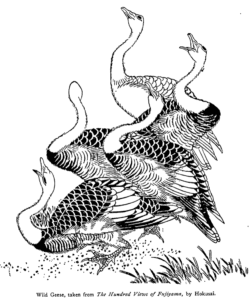
he Man-gwa, designing at the same time an immense quantity
* The first volume is dated 1814, and the second, third, and fourth all appeared in order after that. From the fifth onwards Hokusai was assisted by his son-in-law and one or two pupils. No. 8 dates from 1819, and Nos.
11 and 12 are after 1830. Nos. 13 and 14, interrupted by the death of the artist, were published in 1849 and 1851.
of illustrations for the principal bookseller in Yedo. But the success of the Man-gwa was phenomenal.
With three tints—a black, a soft grey, and sometimes a light brick-red—three little cups placed by his side, the artist produced effects perfectly imitating nature. It seems—and on this subject we should like further knowledge—that the Japanese painter had some particular education of the eye, and that he was aided by it and a trained and carefully-instructed memory. This will explain the apparent emptiness of his outlines, the simpleness of his decorations, and the dreamy look of his drawing of solid objects. One notices the same with artists who get quite familiar with some subject and then turn their back on it in order to reproduce it better. In fact, their eye is naturally photographic, and takes, as it were, a twofold notice of objects.
Let us glance at the ” rapid sketches.” Grotesque and grinning gods, scenes of every-day life, pleasant and otherwise—types of artisans, jesters, conjurors, jugglers, beggars, bathers, travellers, birds, beasts, fishes, insects, and Mowers—views of mountains and seascapes, studies of trees and grasses, buildings, and landscapes ; these, although only in one volume, are almost a summary of the whole series ; and there are more than three hundred sketches on fifty pages. It is, in fact, an entire review of the Japanese people. The personages and the objects represented are hardly two inches high, and are thrown carelessly from top to bottom of the pages, withoutground to stand on or background to give them relief. But they are in such thoroughly natural attitudes, each having its peculiar movement and characteristics, that they seem ready to move, and one may truly say they appear full of life. In this first volume of the Man-gwa, too, that
deep sense of humour, which is one of the most striking traits of the Japanese and which Hokusai shared so strongly that it is shown on every page of his illustrations, is most strongly revealed.
In quickly analysing the subsequent volumes, we may mention, in No. 2, dragons, reptiles, recluses working miracles, scenes of manufacturing business, wrestling contests, physiognomies reproduced in masks, effects of snowclouds, the aurora borealis, natural curiosities, rare animals—a museum of endless variety without method or choice.
In No. 3, semi-human monsters, a terrible figure of a Japanese Gorgon, chaotic landscapes and hideous combinations of the elements evolved in a delirium unknown to us.
No. 4 appears to be one of the most interesting, with its demonology, its sketches of trees seen by night, full of snow, whipped by the wind, beaten by the rain, and with its airy landscapes, mingled with clever reproductions of life.
No. 5 contains pages full of theatrical scenes, romantic pictures, and striking views of architecture gathered together on some journey.
Somehow it seems as if they had been copied from Chinese models. This, also, is noticeable in No. 6 ; but this number contains wonderful studies of movement some handsome horses, and a whole collection of people fencing, shooting with cross-bows, and wrestling
No. 7 contains hardly anything beside landscapes and aspects of nature. One finds in it geological curiosities and quaint effects of cloud and fog, far-stretching landscapes, and bird’s – eye views of whole countries. It belongs to the sort of book called Meisho —a species of traveller’s guide-book which teaches one all that is to be considered interesting: in a country.
Every province has its Meisho; and Hokusai himself, when he designed the
FugakuHyakukei, or The Hundred Views of Fuji, did not intend to do more than add a volume to this series of picturesque guides.
In No. 8 there are some very remarkable grotesque faces, and some studies of very fat and very thin men, which are full of vitality ; in No. 10 some very graceful figures of women, some battles, and some imaginary battle-scenes. Hokusai now enlarged the size of his books, and produced some genuine works of art.
There is in No. 10 a wonderful series of prodigies shown at fairs, and little people making speeches ; and besides these, mythological creatures that make one’s flesh creep, and many fanciful drolleries —in fact, a surprising collection of the real and the unreal. In the 11th and 12th numbers is a capital collection of painters at work, actors, clowns, men making grimaces with hideous appearance.
Lastly, Nos. 13 and 14 are quite up to the standard of the rest ; no weariness shows itself—one finds the same lovely figures and charming landscapes sketched with the same firmness, with the same freeness of hand which characterises the former numbers.
ARY RENAN.

